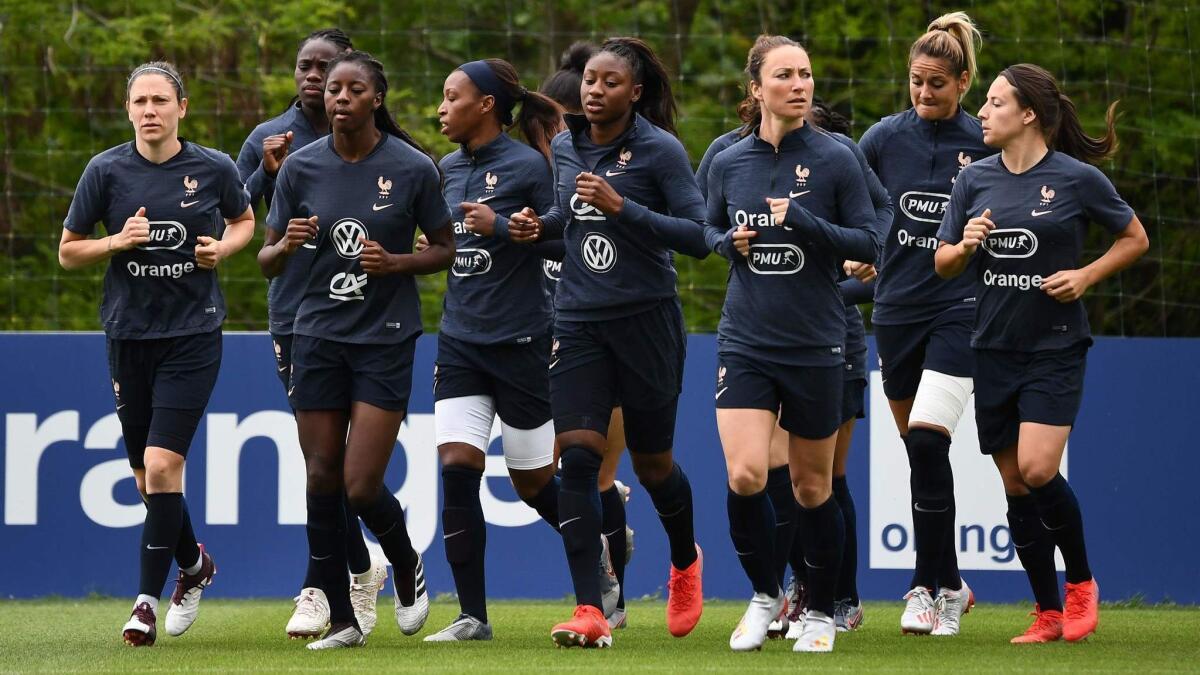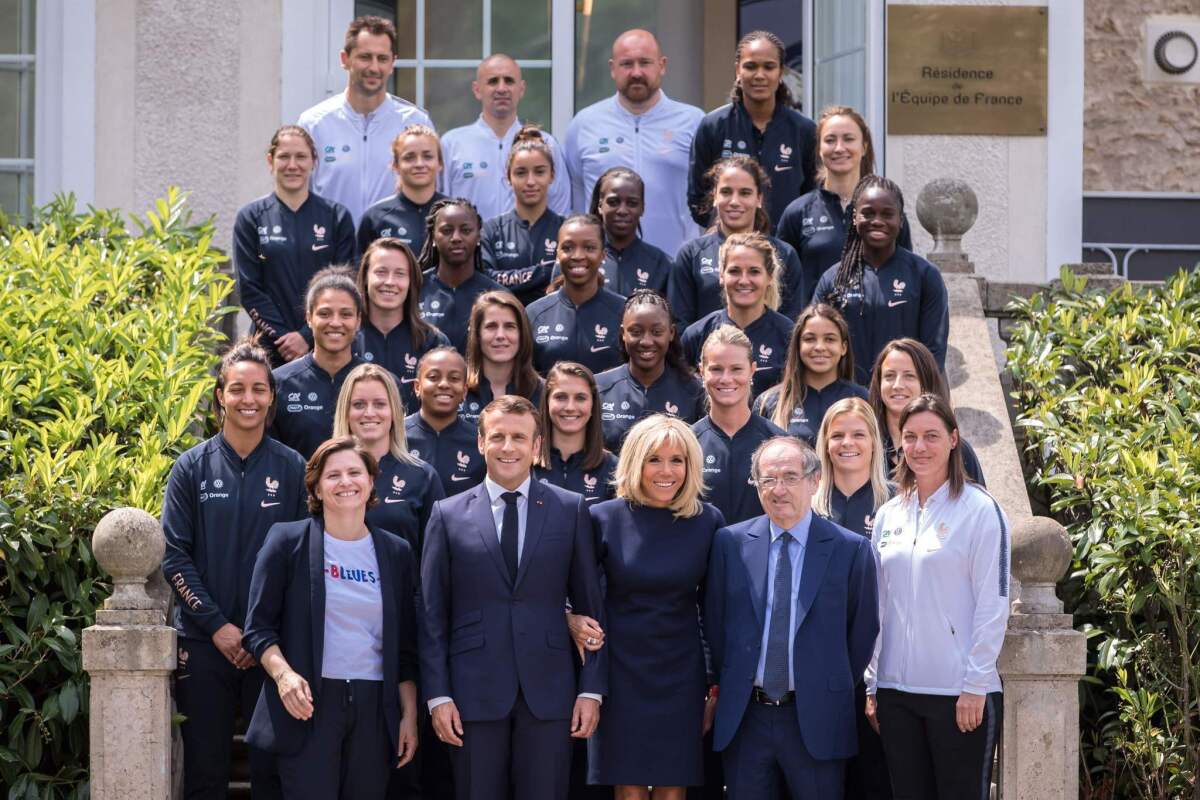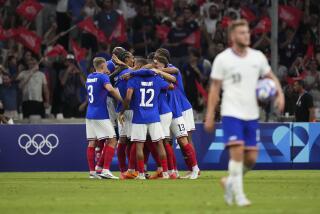Women’s World Cup: France’s growing diversity is the foundation of its soccer success

Reporting from Paris — The neighborhoods surrounding Paris are the most fertile grounds on Earth for producing World Cup soccer players.
Since 2002 the banlieues, or suburbs, of greater Paris have sent 60 players and coaches to the World Cup, more than any other city anywhere. Six were on the French team that won the men’s title last summer in Russia, a team that included 16 players from immigrant families who used soccer as a way to both adapt and advance.
The French women’s team, which will kick off the Women’s World Cup it is hosting Friday against South Korea, is no different. Two of its 23 players grew up in greater Paris and 11 trace their roots to Africa, the Caribbean or the Indian Ocean island of Reunion.
It is a rich, disparate and rare mix, one that reflects the country’s growing diversity. But mostly it’s one that makes the French really good at soccer.
2019 Women’s World Cup: The Ultimate Guide »
Having already won the men’s championship, France can make history this summer if its women, ranked fourth in the world, also win their World Cup. No country has ever held both titles at the same time.
And that success will not just be unprecedented, it will also be tough to copy since it sprang from conditions that, in many ways, exist in few places outside France.
“It speaks to the multicultural makeup of France. But it also speaks to football being a working-class sport,” said Danny McLoughlin, the head of soccer research with the Danish firm RunRepeat, which last year released a detailed survey on French soccer. “Many of these players come from the poor suburbs around major cities like Paris, Lyon or Marseille. Their parents or grandparents moved in search of a better life from former colonies like Senegal, Tunisia, Morocco, Cameroon, Ivory Coast, Ghana and more.
“It calls back to the favelas of Brazil that were thought to produce such great talent because all there was to do there was play football. Well in Paris, in the banlieues, football is all there is.”
And the French have become very good at cultivating the bounty that environment produces. Many banlieues have publicly-funded sports clubs to train players and get them into organized games. From there, the best ones are recruited to Clairefontaine, the national soccer academy just outside Paris, where they work with the best coaches in the country.
“It comes down to poor conditions in immigrant neighborhoods that have led to a real competitive street-football culture where everyone plays,” McLoughlin said. “The French capitalized on this culture by introducing sports clubs with qualified coaches and a path to the national soccer academy.”
In the past decade, that system has worked exceedingly well, turning out players such as Kylian Mbappe, 20, the star of France’s world championship men’s team. On the women’s side, Clairefontaine may be even more important, serving as the finishing school for Elise Bussaglia, Eugenie Le Sommer, Kadidiatou Diani and Amandine Henry, the core of the national team.
Women’s World Cup has come a long way from shaky beginnings »
“For several decades, the French Football Federation and the professional clubs been have engaged in the training of young talent. Perhaps what differentiates us is the modeling of our development program toward the elite,” said Hubert Fournier, the federation’s technical director.
Clairefontaine, about 40 miles outside the capital, is the largest and best known of the French soccer centers. But it is just one of 12 elite academies — there are seven for female players — run by the federation, all of which Fournier said operate under the same principles and which were collectively responsible for producing 40% of the players on France’s World Cup-winning team in 2018.
From an early age, players with potential are monitored nationwide, and those showing exceptional talent are funneled into an academy or elite sports section. The best of those players will then be invited to join a training program managed by the federation or a professional club.
“What is true about French football is that they started building academies very early and structuring them very early,” Rudi Garcia, who played 10 seasons in France before becoming a coach, said through an interpreter. “A lot of the good work that’s being done by French football in general is due to the academies.”

Added Florian Thauvin, a product of the youth system who played on last year’s world championship team: “You learn when you are a kid. It’s the best time to learn the technique. We also have a lot of good coaches for the young players.
“We can conclude from that that we have the best training system in the world.”
But if that’s how the players are finished, where they start, many times, is on the streets.
“The suburbs, in Paris in particular, have a real street football culture,” said McLoughlin, who argued that the federation’s academy system wouldn’t be nearly as successful without the foundation supporting it.
“I wouldn’t discount the culture, the love of the game,” he said. “For young men, football is everything. It is the only sport in their eyes. The public funding and coaching is what tips it over the edge.”
What made the U.S. women’s World Cup win in 1999 such a pivotal moment? »
Also helpful is the fact that metropolitan Paris is home to more than 12 million people and an astounding 4,500 soccer fields, making it no surprise that the area produced 65% of the male French players currently playing professionally, according to Jean-Claude Lafargue, Clairefontaine’s director.
“We grew up playing just below our building,” said Presnel Kimpembe, a World Cup champion whose father is from the Congo and whose mother is from Haiti. “That’s how it was in our area.”
That tradition has had less of an impact on the women’s side since only two players, Diani and Aïssatou Tounkara, come from the Paris suburbs. But, like the men’s team, the women’s roster is deep with immigrants and the children of immigrants, which Diani, whose family comes from Mali, says is one of the national program’s greatest strengths.
“Diversity is really a positive in a country or even a team,” she said through a translator. “Maybe it’s the reason why France won the World Cup, this multiculturalism. It represents France.”
That’s been true for decades on the men’s side. In 1998, when a multiethnic French team won its first World Cup in Paris, the team was nicknamed “la France black-blanc-beur,” for black, white and North African. The success of that team and the developmental environment that produced it has changed things for the women as well, with Aime Jacquet, the visionary French coach, using it to push the federation to provide extra resources for females, including opening Clairefontaine to girls for the first time.
Still, it took years for the diversity that marked the men’s team to become obvious on the women’s side. Laura Georges, part of the second female residency class at Clairefontaine, represented France in three World Cups but said for years she was the only black player on the team.
“Now people are like, oh, well the national team is black? People expect France to be white. No, it’s not,” said Georges, whose family in from Guadeloupe, a French island in the southern Caribbean. “They are black or they are white or they are from Arabic origins.
Sign up for our weekly soccer newsletter »
“They took the best players who could work together. And I like the atmosphere. Everyone can see ‘OK, it can be me.’ Everyone can relate to one of the players from the national team.”
France’s soccer revolution began with a societal one. Fermented in the despair of dislocation of the immigrant-heavy banlieues surrounding Paris, its players were lavished with government and federation support and the result is a system that the rest of the world can envy — but given the conditions, probably not rival.
“France has football history, France has diversity and multiculturalism,” said LAFC’s Bob Bradley, a former U.S. national team coach who once worked in France. “And all that amounts to is talent. It has interesting, exciting talent.”








